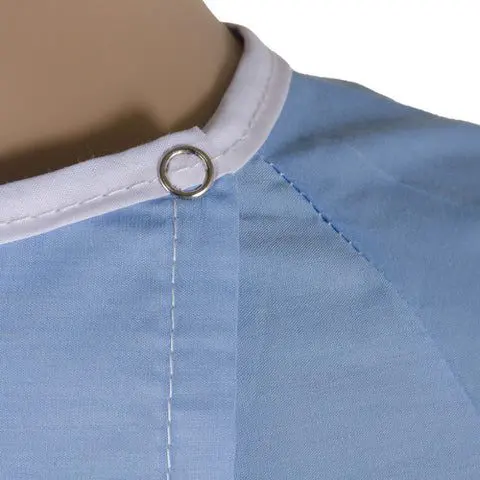10 Types of Hospital Gowns: How to Know What’s Right for You

Sure, it may seem like all types of hospital gowns are created equal, but there are key differences that are important to understand. And, these differences bring added comfort and safety at a time when they’re so needed. Most gowns follow the same basic shape, yet they’re designed for different purposes. At the most basic level, some gowns are meant to be worn by medical staff, while others are designed for patients. After this fundamental distinction, it’s critical to understand what type of gown is appropriate for you or your care recipient, based upon individual abilities and circumstances.
But, before we share the “Top 10 list,” it’s important to know that when it comes to comfort, practicality, and your specific situation, you may want to consider alternative options. These alternatives, known as adaptive clothes, are designed to be particularly easy and quick to put on and take off for people living with physical and cognitive changes or disabilities.
Now, here’s what you need to know about the 10 types of hospital gowns:
1. Full-back gowns
These gowns cover the entire back and are often secured with ties. They’re typically made of a lightweight, breathable fabric. They’re often preferred by patients for their modesty and comfort. They are often made of lightweight, breathable fabric. Cotton or a poly-cotton blends help to keep patients comfortable during their hospital stay. Full-back gowns are typically preferred by patients for their modesty, as they offer more coverage than other types of hospital gowns. In addition to being comfortable and modest, full-back gowns are also practical, as they allow for easy access to the back for medical procedures and examinations. Many full-back hospital gowns are designed with openings in the back that can be easily closed and reopened with the use of snaps or ties, making it easy for medical staff to access the patient’s back without having to fully remove the gown. Full-back hospital gowns are a common choice for patients in hospitals and other healthcare settings, and they are available in a range of sizes to ensure a good fit for patients of all shapes and sizes.

Open back hospital gown
2. Split-back gowns
As their name suggests, these gowns are known for a split in the back that allows for easier access to the patient’s body. They’re often used for those who need frequent medical attention or for those who are bedridden. Split-back hospital gowns are typically made of lightweight, breathable fabric, such as cotton or a poly-cotton blend, to help keep patients comfortable during their hospital stay. They are often secured with ties and may also have snaps or Velcro closures to help keep the gown in place. Like full-back hospital gowns, split-back gowns are available in a range of sizes to ensure a good fit for patients of all body types. They are a practical and convenient choice for patients in hospitals and other healthcare settings, and they can help to make the hospital or rehab experience more comfortable and dignified for those who need to spend extended periods of time in bed.
3. Snap-front gowns
The snap closure in the front allows for easy access to the patient’s body while also providing a certain degree of modesty. This is a great type of hospital gown for those who want to keep it secure from the front. They’re often preferred by patients who need frequent medical attention but want to maintain their modesty. Snap-front gowns allow for easy access to the chest and stomach area for medical procedures and examinations without the need to fully remove the gown. Snap-front hospital gowns are typically made of lightweight, breathable fabric, such as cotton or a poly-cotton blend, to help keep patients comfortable during their hospital stay. They may also have ties or other closure methods to help keep the gown in place.Snap-front hospital gowns are a popular choice for patients in hospitals and other healthcare settings, as they offer a combination of convenience and modesty. They are available in a range of sizes to ensure a good fit for patients of all shapes and sizes.
 Snap-front hospital gown
Snap-front hospital gown
4. Reusable gowns:
These gowns are designed to be worn multiple times and can be laundered after each use. They are often made of a more durable fabric and are a more environmentally friendly option compared to disposable gowns. Certainly, when it comes to not only being “reusable,” but also multifunctional, you may want to consider adaptive clothing options specifically for older adults, such as Joe & Bella’s open-back adaptive nightgown for women, or the flannel nightgown for men, or the all-seasons adaptive pajamas for both men and women. These smartly designed adaptive options provide the same level of comfort and modesty as traditional hospital gowns, while also being quick and easy to get on and off particularly for those living with motor, mobility, and cognitive changes. One huge advantage of adaptive items is that they become a permanent addition to a wardrobe – whether worn at home, a care community, or a hospital. And since these gowns are much more comfortable and aesthetically pleasing, the wearer will feel more at ease with this type of clothing than a traditional hospital gown.
5. Bariatric gowns
This type of hospital gowns is designed for patients who are significantly overweight and require a larger size to provide a comfortable fit. They’re often made of a more durable fabric that may have reinforced seams.
6. Incontinence gowns
These gowns are designed for patients who have difficulty controlling their bladder or bowel movements. They’re made of a waterproof or absorbent material and may have additional features such as absorbent pads or a snap-front closure.

Incontinence hospital gown
7. Disposable gowns
These types of hospital gowns are designed to be worn once and then disposed of. They’re often made of a lightweight, breathable fabric and are used in settings where there is a high risk of contamination or when a reusable gown is not available.
8. Isolation gowns
These gowns are worn by patients who are isolated or quarantined due to a contagious illness or infection. They’re designed to prevent the spread of the illness to other patients or medical personnel and are often made of a waterproof or fluid-resistant material.

Isolation hospital gown
9. Thermal gowns:
These gowns are designed to keep patients warm and are often used for people who are hypothermic or have difficulty regulating their body temperature. They’re made of a thermal or insulating material and may have additional features such as a built-in heating pad or a hood to keep the patient warm.
10. Pediatric gowns
Specifically designed for children, this type of hospital gown is often more colorful and playful than adult gowns. Made to fit smaller bodies, they often sport special features such as tie closures that are easier for small hands to manipulate.

While the classic open-back hospital gown might be what you’re most used to seeing, there are a lot of great options depending on your needs. And there are some interesting new designs that are currently being created, like Care + Wear’s innovative hospital gown, which is shown below.
























